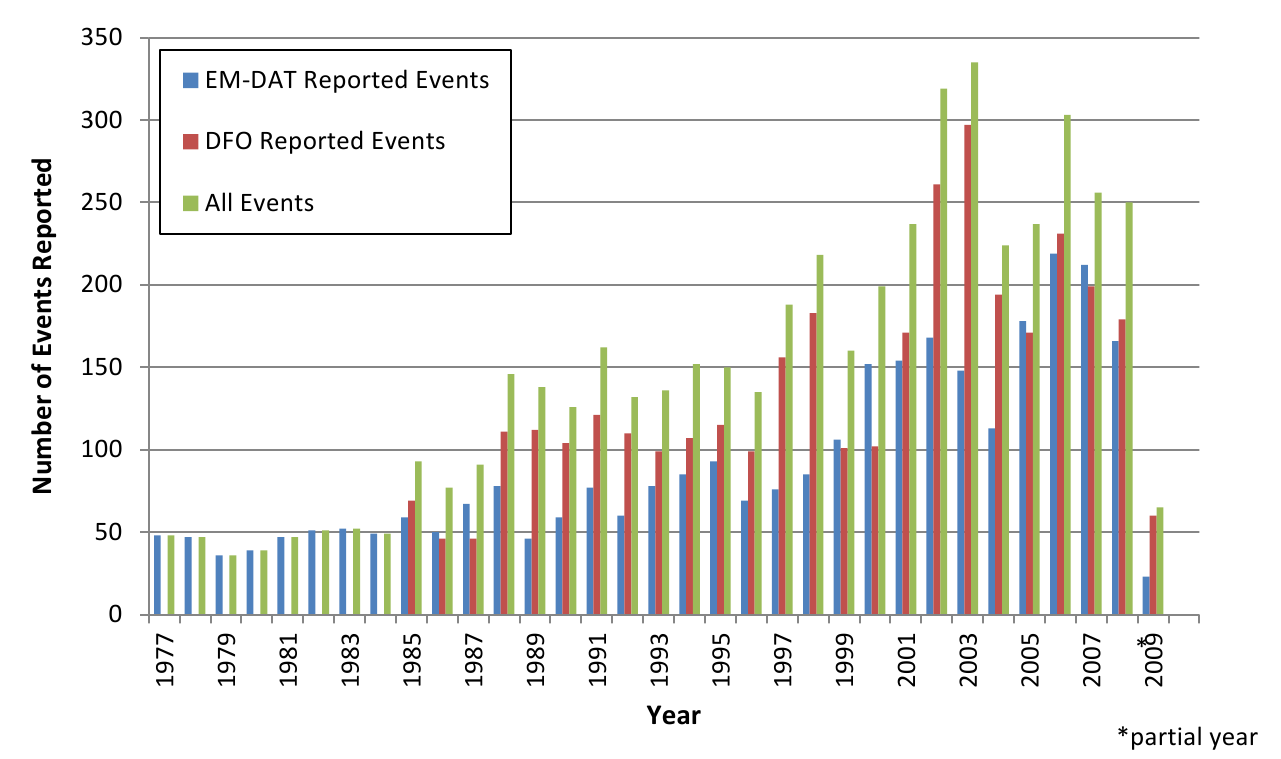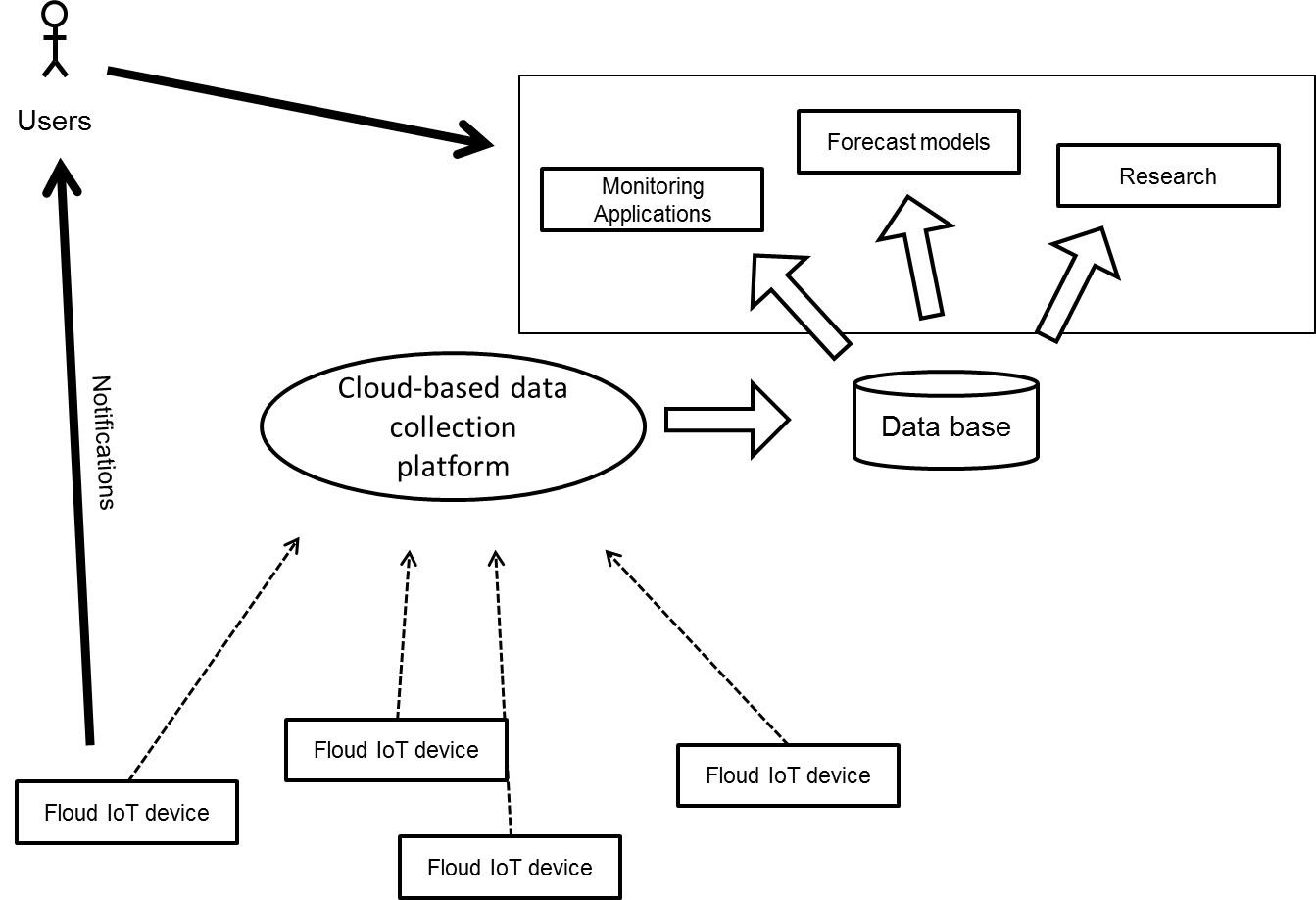Floods are the most common natural disaster and the leading cause of natural disaster fatalities all over the world. The risk of fatal losses due to flooding is extremely significant when accounting for deforestation and the increasing proximity of large population to coastal areas, river basins and lakeshores.
Recent accelerations in the growth of human population and changes to the land use patterns have increased human vulnerability to floods. Harmful impacts of floods include direct mortality and indirect displacement and widespread of crops, infrastructure and property.
 Table - Reporting of wordlwide flood events by source and year.
Table - Reporting of wordlwide flood events by source and year.
Given that flood losses are likely to increase in future years, increased attention to flood prevention, monitoring and mitigation strategies is necessary. To date, early warning systems have been an effective mechanism for reducing the impact of floods, however, they are not ubiquitous and should be prioritized in less developed countries with large at-risk populations and high frequencies in flooding. It is important that messaging and targeted communication strategies accompany early warnings so that the population understands the impending risk and can respond appropriately. Many flood fatalities are associated with risk-taking behaviors, thus messages to avoid entering the flood waters and to curtail risky activities in all stages of the event may be successful in reducing flood fatalities. Additional, improved land use planning and regulation of development can mitigate flood impacts. Studies on the relationships between flood losses, natural hazard characteristics, and societal and demographic vulnerability factors can aid in informing and prioritizing flood prevention and mitigation strategies. Finally comparisons of the effectiveness of different policies and mitigation strategies can inform future strategy and policy actions and ensure they are appropriate in specific contexts.
Given the significant number of events involving floods in urban areas, it is important to develop an initial understanding of the problem, in order to provide a description of the state of the art of modern models.
Floods in urban areas are characterized mainly by:
- The interactions between the natural flood mechanisms and different urban drainage systems, and features.
- The scale of the flooding (localized, town-wide, river catchment wide)
- Frequency of flooding
- Consequences of flooding (degree of nuisance, cost, etc.)
The main challenge is to develop generalized tools which are able to deal with the interactions of any of the ground-level flows, with the below-ground drainage systems.
An idea is proposed, to enhance existing models, and to force them not with high resolution, initial static data, but rather to feed them a high number of information reflecting the status of a flood, which is updated in time as frequently as possible. The approach would allow for minimizing the length of forecast that a model is employed to provide, thus minimizing the error that generally increases together with the length of the forecast. This approach also allows for novel methods of issuing early-warnings to the population.
In the framework of management and better forcing of existing flood prediction models, an IoT device (Floud) is introduced. Such device embeds a sensor capable of detecting different flood-related conditions (presence of water, water elevation, flow pressure, water temperature, turbidity, etc.), and communicates the detected data to the cloud, at regular time intervals. A cloud-based data collection software is responsible of receiving and storing the measured data, and to pair each measurement with the geographical location of the device it originates from. Several client applications can consume the stored data.
- Global early-warning triggers can be set according to customizable set of conditions
- Warnings can be spread out to the population via SMS
- Individual citizens have access to the data from the website
- Individuals...
Read more »

 designlab.ac
designlab.ac
 Adam Moussa
Adam Moussa
 Weishan (Wesley) Yang
Weishan (Wesley) Yang
 EmericB
EmericB